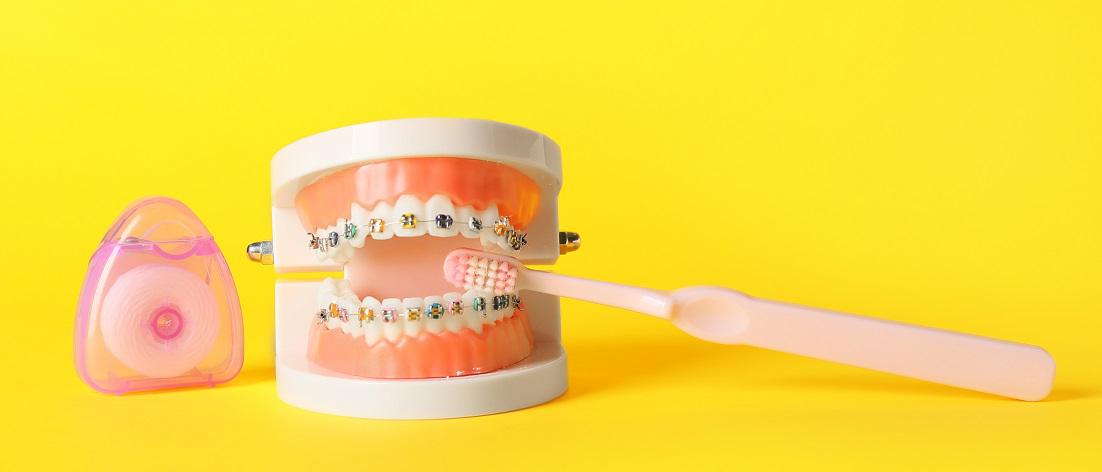 In 24 months or less, you could have the smile of your dreams! Straight, white, beautiful teeth will give you new confidence and improve the first impression you make on people. You’ve committed to wearing braces so that you can enjoy a head-turning smile for the rest of your life. Great! But while you’re in braces, you’ll need to spend time each day brushing, flossing, and cleaning your mouth. In addition, there are certain foods you should avoid and bad habits you should break.
In 24 months or less, you could have the smile of your dreams! Straight, white, beautiful teeth will give you new confidence and improve the first impression you make on people. You’ve committed to wearing braces so that you can enjoy a head-turning smile for the rest of your life. Great! But while you’re in braces, you’ll need to spend time each day brushing, flossing, and cleaning your mouth. In addition, there are certain foods you should avoid and bad habits you should break.
In today’s blog, you’ll learn:
-
How to brush and which tools can help
-
Tips for keeping your mouth and teeth clean between meals
-
How to floss and which tools can help
-
Foods to avoid, to protect your teeth and braces
Practice Diligent Daily Oral Hygiene
Before you got braces, brushing and flossing were important ways to deter tooth decay, gum disease, and bad breath. With braces, oral hygiene is even more important because braces trap food particles, plaque, and tartar against teeth. If you don’t remove plaque, within a few days it will calcify into tartar, a hard-to-remove, insoluble substance. Decaying food particles, plaque, and tartar will cause cavities and contribute to the development of gum disease, which increases systemic health risks.
In addition, white spot lesions (WSLs) can develop around brackets. WSLs areas appear when tooth enamel becomes demineralized, and the “scars” can last forever. When the acid produced by plaque leaches minerals from tooth enamel, WSLs develop. To avoid demineralization around orthodontic brackets, keep your teeth free of plaque and pay special attention to cleaning around brackets. A fluoridated mouthwash can help remineralize teeth, as well.
We want your orthodontic treatment experience to produce an amazing, healthy smile, and we’ll certainly do our part–but you must commit to doing your part, too.
Brushing with Braces
These tips will help you maintain healthy, clean teeth and gums while wearing fixed braces:
-
Use a soft-bristled toothbrush for primary brushing and interdental/interproximal brush afterward
-
Use fluoridated toothpaste
-
Focus on thoroughly brushing just three teeth at a time
-
For each tooth, brush the front, back, and chewing surfaces
-
Pay close attention to brushing between the brackets and gumline because plaque that accumulates at the gumline will promote the development of gum disease and WSLs
Brush and floss after each meal (take a toothbrush, floss, and paste with you when you leave home)
-
If possible, use a Sonicare electric toothbrush
-
If desired, use a tongue scraper morning and evening
-
If desired, rinse with fluoridated mouthwash after brushing
-
If desired, chew sugar-free gum to help remove debris after snacks when you cannot immediately brush and floss
-
Stay hydrated; a moist mouth helps rinse away food particles and bacteria
-
Attend regular six-month checkups and cleanings with your dentist
Flossing With Braces
Most people don’t floss their teeth daily, but flossing isn’t difficult. The positive effects flossing has on dental health are well worth the effort. For orthodontic patients with fixed braces, flossing is more involved because archwires block floss from reaching the gumline between teeth. However, thorough, twice-daily flossing is imperative for all orthodontic patients.
You’ll need to use a floss threader, a tool that looks like a large, dull plastic needle, to thread floss under archwires. At first, flossing will be cumbersome and time-consuming, but with practice, you’ll become a speedy professional.
We cannot stress enough the importance of flossing while wearing braces. Don’t neglect to floss or rely on an interdental brush as a substitute for flossing. The only proper way to floss your teeth is with actual dental floss.
Follow these steps at least twice daily, but preferably after meals and snacks, as well.
-
Thread your floss threader
-
Start in the upper right quadrant of your mouth, working left to right, top then bottom arches
-
Thread the floss under your archwire
-
Gently tug on both ends of the floss, working it down to the gum line,
-
Around the tooth’s side, then
-
Up the side, moving in and out, up and down
-
Repeat steps 4-6 on the adjacent tooth
-
Repeat step 6 four times between every two teeth
-
Remove floss from between the cleaned teeth
-
Reinsert floss under the next section of archwire
-
Repeat steps 3-9
-
Thread a new piece of floss when necessary
-
Once you’ve thoroughly and completely flossed, throw away the floss and rinse the threader
-
If possible, use a water flosser
-
If desired, rinse with a fluoridated mouthwash after flossing
Foods and Drinks to Avoid while Wearing Braces
Foods and drinks rich in sugar, as well as sticky, tough, crunchy, and hard foods can harm your braces and your teeth. Hard candy, suckers, and sugary beverages expose teeth to sugar over a long period, which is particularly hard on tooth enamel. Sweet drinks should be consumed using a straw, but water is always better.
Remove these foods and drinks from your diet while wearing braces, and add more water to your menu.
-
Jolly Ranchers, taffy, and hard candies
-
Popcorn (the kernels harm braces)
-
Sugary beverages, like sodas and sports drinks
-
Meat jerky, tough meats
-
Crunchy vegetables, nuts, and chips
Call Us for Your Orthodontic Consultation
If you think that you or your child needs to be evaluated by an orthodontist, call us today. Our dental team is accepting new patients, and we’re happy to work with children as young as six years of age. Note that no adult is “too old” for braces! Our orthodontic team will conduct a comprehensive orthodontic evaluation, then provide you with our findings and, if necessary, a treatment plan. We can file your insurance and offer payment plans to make orthodontic therapy affordable for virtually any budget.


